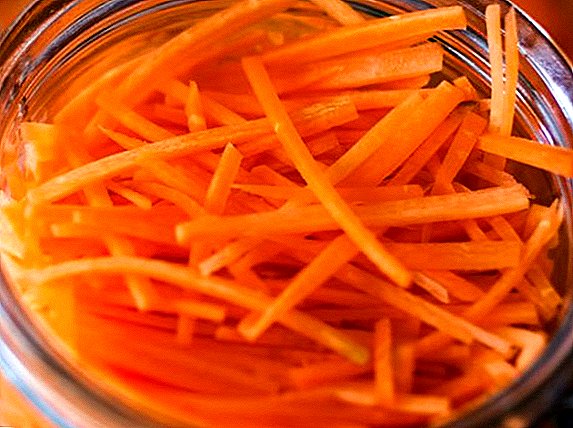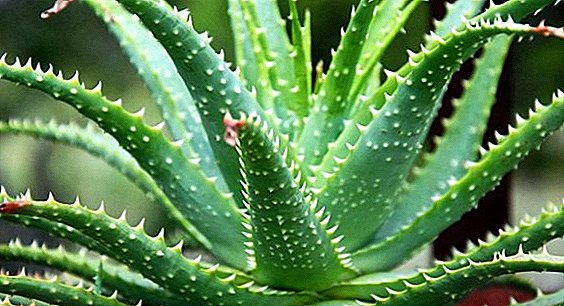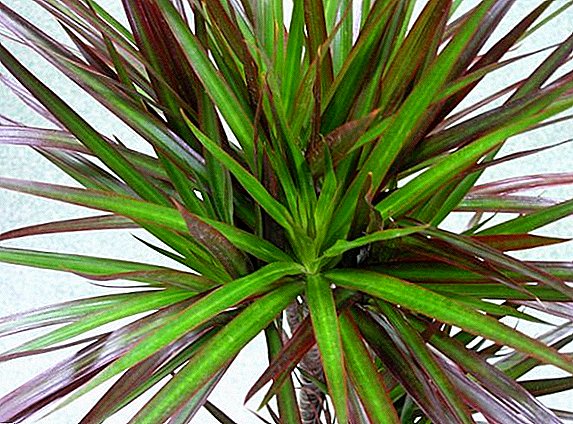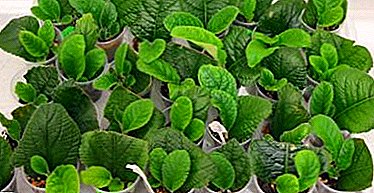
Streptokarpus is a very capricious plant, it needs special care. It is not at all easy to contain this representative of the Gesneries in the apartment. Streptocarpus is even harder to reproduce at home. But this article will help to avoid many difficulties in the reproduction of streptokarpusa and achieve results.
How to breed?
Streptokarpus multiplies seeds, cuttings. The ideal breeding season is February - April. The time when the sun begins to warm, favorably contributes to the growth of the flower.
Cuttings
Leaf grafting is the easiest method of reproduction streptokarpusov. This plant has large leaves, some can reach up to 25 cm in length. A leaf of this size will not survive if it is planted entirely. For reproduction by leaf it is necessary to take parts of a sheet plate. The selected piece of leaf must be healthy, without stains and a uniform green color.
It is also important not to make a mistake with the age of the leaf. Too young sheet takes time to gain strength. And the old can simply curl.
From seed
Streptocarpus seeds can be purchased at any flower shop. They are packed in paper bags. Fresh seeds have the best germination., ideally - just collected. Therefore, it is very important when buying pay attention to the date.
Step by step instructions: how to multiply at home?
Soil and fertilizers
 Soil for growing babies Streptocarpus should choose a loose, breathable, not too nourishing and well-preserving moisture. Suitable universal floral soil or soil for Saintpaulia.
Soil for growing babies Streptocarpus should choose a loose, breathable, not too nourishing and well-preserving moisture. Suitable universal floral soil or soil for Saintpaulia.
The substrate is prepared as follows.:
- mix 2 parts of soil for violets;
- 2 pieces of perlite and vermiculite in the same proportions.
You can make a special mixture for rooting the leaves, just mix peat and sand in equal parts.
Watering
Planted parts of the leaf should be watered moderately so that the soil is wet, but not wet. Watering is carried out as needed about once a week. For optimal distribution of moisture in the pot should be watered the edges of the tank.
Humidity
Streptokarpus extremely sensitive to humidity in the room. Prior to the formation of roots, the cuttings lack water-absorbing organs. Moisture is absorbed by the whole sheet, so moisture should be sufficient. Usually the moisture that is formed on the package is sufficient for rooting.
Temperature
In the room where the plant is grown, the temperature should be at least 20-25 degrees.
Features of growing from seeds
 The seeds of streptocarpus are very small, more like dust particles. therefore planting seeds is a very painstaking exercise, it should be taken very seriously and with great care.
The seeds of streptocarpus are very small, more like dust particles. therefore planting seeds is a very painstaking exercise, it should be taken very seriously and with great care.
- First you need to prepare shallow containers. At the bottom of each lay drainage. Pour peat mixed with sand over drainage.
- To facilitate planting seeds they can be mixed with fine sand.
- You do not need to bury the seeds in the ground, otherwise they will dry out, just cover them with glass or film.
Important! Before planting, the substrate should be moistened, the seeds should be sown on moist soil.
We offer you to watch a video about planting streptocarpus seeds:
Leaf fragment
There are two ways of propagation of streptocarpus with leaf fragments:
Standing
- The sheet is cut across. A knife, blade or other sharp object is suitable for this.
- Before carrying out the procedure the instrument must be sanitized.
- Each piece of the sheet should be 5-7 cm.
Landing by this method gives fewer children, but they appear much faster (7-10 days). One more the advantage of standing up is a small chance of leaf rotting, since the cut line is smaller. If the rooting conditions are not observed, this method is more reliable.
We invite you to watch a video on the reproduction of streptocarpus leaf standing:
Toaster
- The sheet must be placed bottom surface up.
- Be sure to remove the central core from the sheet plate.
- For planting will need halves of the sheet.
 The advantage of this method is getting a lot of babies. Before planting, the sheet should be washed with warm running water.
The advantage of this method is getting a lot of babies. Before planting, the sheet should be washed with warm running water.
If the sheet was bought somewhere at exhibitions from collectors and while it was being carried home, he rolled up, then it is advisable to put it in warm water and wrap it in a damp napkin, then place it in a plastic bag. For planting fit shallow containers. Before planting, the lower sections are preferably dried for 5-10 minutes. Fragment of the sheet is dug into the soil by 6-10 cm.
We invite you to watch a video on the reproduction of streptocarpus leaf toaster:
Rooting sheet
 Rooting of leaf fragments takes about two weeks.. The appearance of babies in the veins of the sheet can be seen after 1.5-2 months. On each vein formed one or two children. After the kids grow up to at least 2 cm, they can be transplanted into a separate container.
Rooting of leaf fragments takes about two weeks.. The appearance of babies in the veins of the sheet can be seen after 1.5-2 months. On each vein formed one or two children. After the kids grow up to at least 2 cm, they can be transplanted into a separate container.
As a dish for transplanting babies, you can use stogrammovye disposable cups. Children should also be kept in a greenhouse, gradually accustomed to room conditions by airing. The separation of children from the sheet causes some difficulties, because their “thin” legs are very fragile and can be easily damaged. All babies need to be treated with a root and plant, without deepening the root collar.
Care
- Lighting. Streptokarpus is a photophilous plant, so it should be grown in a well-lit place. But it is necessary to avoid hit of direct sunshine that the flower did not wilt.
- The room. Grow streptokarpus better in a room where there are no drafts. They can not stand this plant, they can cause diseases of the flower and its death.
- Features of seed care at home:
- Watering is carried out using a pallet. It is impossible to water from above, otherwise you can wash out all the seeds.
- After the formation of the first leaflets seedlings should be aired.
- When the real leaves begin to grow, you can make the first pick. To do this, plant the plants in a larger pot so that they do not interfere with each other.
- Features care for leaf shoots:
- Put the dishes with the planted parts of the sheet in a plastic bag.
- It is not necessary to do openings for airing.
- It is desirable to avoid contact between the leaves and the package, you can build special props.
- To put a greenhouse in a warm and well-lit place.
Diseases and their treatment
Reproduction of streptocarpus takes place in the greenhouse, which is necessary to create optimal conditions for germination. But this can provoke the reproduction of harmful bacteria that destroy the plant already at the cutting stage. Streptocarpus is susceptible to fungal diseases with inadequate care - powdery mildew, gray mold. You should also protect the plant from spider mites, whiteflies and thrips.
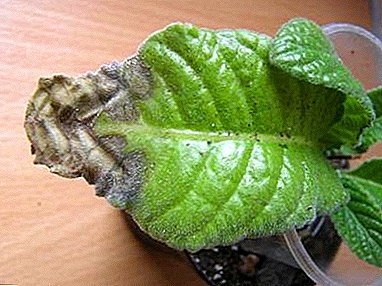 Thrips. The first sign that the plant is sick - its leaves begin to dry quickly. Stop this process is very difficult. Treatment: the use of an insecticide. For faster treatment should increase the humidity and reduce the temperature in the room.
Thrips. The first sign that the plant is sick - its leaves begin to dry quickly. Stop this process is very difficult. Treatment: the use of an insecticide. For faster treatment should increase the humidity and reduce the temperature in the room.- Spider mite. The name speaks for itself, when the disease appears on the leaves of a spider web and flower stalks dry out. The method of struggle is the same as with thrips.
- Late blight or virus. Symptoms of the disease - the presence of dark mosaic spots. This disease cannot be cured, so the only thing that can be done is to throw away the diseased plant.
- Mealy dew. The disease manifests itself by the formation of white dust or flour on the plant. Control measures:
- removal of affected parts;
- replacement of topsoil;
- processing plants and soil antifungal agents.
- Gray rot. The disease manifests itself as the formation of brown spots on the stems and leaves. The treatment consists of removing the affected parts and treating the plant and soil with fungicides. Be sure to combat fungus need to revise the conditions of the streptokarpusa. For the prevention of disease can be sprayed once a week cuttings of bactericides.
Reproduction streptokarpusa - a long and complex process. It is necessary to choose the right breeding method. Cutting is a more reliable method of reproduction, and with the seed method you can get unpredictable colors. Observing all the rules and conditions of cultivation, you can achieve the appearance in the house of this beautiful flowering plants.


 Thrips. The first sign that the plant is sick - its leaves begin to dry quickly. Stop this process is very difficult. Treatment: the use of an insecticide. For faster treatment should increase the humidity and reduce the temperature in the room.
Thrips. The first sign that the plant is sick - its leaves begin to dry quickly. Stop this process is very difficult. Treatment: the use of an insecticide. For faster treatment should increase the humidity and reduce the temperature in the room.
